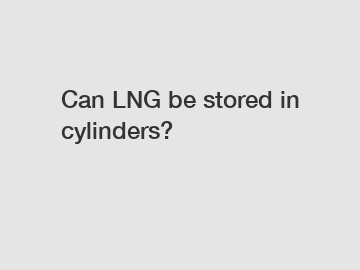Can LNG be stored in cylinders?
Liquefied natural gas (LNG) has become an increasingly popular alternative to traditional fuels due to its lower emissions and cost-efficiency. However, one question that often arises is whether LNG can be stored in cylinders. The answer is yes, but with certain precautions and considerations.
Storing LNG in cylinders is technically possible, but it requires specialized equipment and safety measures due to the extreme cold temperatures and high pressure involved. LNG is stored at temperatures as low as -260°F (-162°C) and pressures above 50 bar (725 psi), which makes it essential to use cryogenic cylinders specifically designed for this purpose.
Cryogenic cylinders are double-walled containers made of stainless steel or aluminum, with a vacuum-insulated space between the inner and outer walls to minimize heat transfer. This prevents the LNG from vaporizing too quickly and maintains its liquid state for longer periods.

The storage capacity of LNG cylinders can vary depending on their size and design. Small portable cylinders are commonly used for applications like refueling LNG vehicles or providing backup power in remote locations. These cylinders typically have capacities ranging from a few liters to a few hundred gallons.
For larger-scale storage needs, such as for industrial or commercial facilities, bulk storage cylinders are used. These cylinders can hold thousands to hundreds of thousands of gallons of LNG and are often interconnected to create a larger storage system. This allows for easy refilling and distribution of LNG as needed.
While storing LNG in cylinders offers flexibility and portability, it also comes with some challenges. One of the main concerns is the potential for leaks or spills, which can be hazardous due to the flammability of LNG. Proper safety measures, such as regular inspections, pressure monitoring, and leak detection systems, are critical to prevent accidents and ensure the integrity of the storage system.
Another consideration when storing LNG in cylinders is the need for proper ventilation and handling procedures. Since LNG is a cryogenic liquid, any contact with skin or eyes can cause severe frostbite or burns. Ventilation is necessary to prevent the build-up of flammable vapor and ensure a safe working environment.
In addition to safety precautions, the cost of storing LNG in cylinders should also be taken into account. Cryogenic cylinders are more expensive than standard storage tanks and require regular maintenance to ensure their proper functioning. However, the flexibility and mobility they offer can outweigh the initial investment for some applications.
Overall, storing LNG in cylinders is a viable option for certain scenarios, such as remote locations or temporary storage needs. However, it is crucial to follow industry best practices and regulations to ensure the safety and efficiency of the storage system.
In conclusion, while LNG can be stored in cylinders, it requires careful planning and implementation to mitigate potential risks and maximize the benefits of this storage method. By using specialized cryogenic cylinders, following safety protocols, and considering the cost implications, storing LNG in cylinders can be a practical solution for meeting the growing demand for this clean and efficient fuel source.
Are you interested in learning more about LPG Storage Tank manufacturer, CNG Tube Skids, CNG Tube Skids? Contact us today to secure an expert consultation!
190
0
0

Comments
All Comments (0)